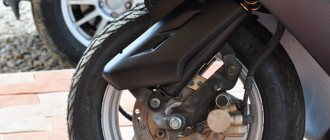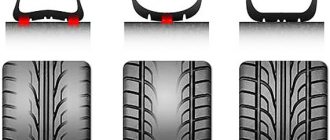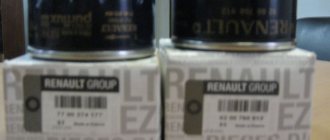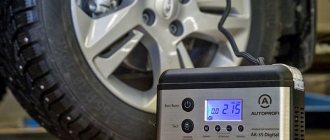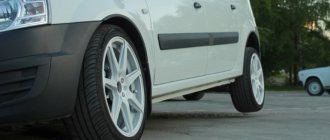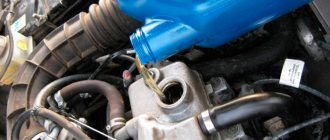The factory tire pressure on the Lada Largus differs from most models of the brand. The modern version for 5 and 7 seats is distinguished by a stiffer suspension and increased dynamics. To meet the specified characteristics, the manufacturer recommends pumping the wheels more. 2.4 - 2.6 BAR (atmospheres) for the front and rear axles is considered optimal. The manufacturer allows adjustments to the pumping of the slopes. In the summer, when the air temperature goes beyond +30⁰С, the tires need to be deflated. This will balance thermal expansion and stabilize the car's behavior.
In winter, on the contrary, you will need to constantly pump up the tires until the indicators normalize.
The driver can see the recommended pressure on the end of the left front door. There is an attached nameplate with complete information.
Tire pressure Largus Cross R15 – 185 65, R16 – 205 55
On a car where size 15 ramps are installed, in the summer it will be enough to maintain the pressure set by the manufacturer. For modifications with 7 and 5 seats, the input parameters will differ slightly. A more spacious car, it requires pumping up the rear wheels to 2.6 kilograms when fully loaded.
Separately, you should consider variations with 16-inch rollers. Here, low-profile slopes with a pumping level of 2.5/2.7 BAR are installed in the drain.
Tire pressure indicators for Lada Liftback in summer
The manufacturer's hint regarding optimal pressure levels can be found on the driver's door center pillar. According to it, the number of atmospheres in such a car should be 2.0 atmospheres on all four wheels with a minimum load. The maximum load of the car provides for a change in indicators to 2.2 Bar on the rear axle and 2.0 Bar on the front.
In the summer, if the car is in a cool garage, the indicators will be the same, but when the car goes out into the heat, the amount of air in the tire will increase. Therefore, before the trip it is worth lowering the pressure by about 0.3 Bar. This way you can achieve the most correct parameters as stated by the manufacturer. The most important thing in this case is to monitor the behavior of the car. If the car skids when turning or excessive fuel consumption is noticed, then you immediately need to check the pressure and bring it to optimal levels. Otherwise you will have to buy new parts and tires.
Properly inflated tires
The pressure must be checked by the driver systematically. If you constantly forget about such a little thing, it can lead to many consequences. When driving a car on a busy highway with the wrong pressure, you can endanger not only yourself, but also other drivers and pedestrians.
How does low or high tire pressure affect
If the optimal level is insufficient, the tire sags in the central part of the tread, which leads to poor handling and intense wear of the tread shoulder.
With excessive inflation, the rubber bulges and only touches the central part. Problems associated with this also affect tire longevity and handling. When maintaining proper inflation, the car drives smoothly, clings well to the road surface, and the slopes wear out slowly.
Review of the best summer and winter tires
When choosing tires, owners take into account the following points:
- manufacturer;
- operating conditions (pay attention to the pattern, tread);
- size;
- price category.
Based on reviews from Lada Largus owners, let's summarize.
The majority of survey participants adhere to the recommended sizes. The most popular non-standard tires are 195/65 R15, 195/60 R15, 205/60 R15.
Top 5 summer tires:
- Nokian (HAKKA GREEN 2, Nordman SX);
- Michelin (Energy XM2);
- Continental (ContiPremiumContact 5);
- Matador (MP 44 Elite 3)
- Amtel (Planet T-301). Attention. Complaints about rapid wear. They can burst at high speed.
The tread pattern is:
- asymmetrical;
- directed;
- symmetrical (universal, therefore the most popular).
The latter is ideal for use around the city. It has an affordable price. The downside is unsatisfactory handling at high speed, on wet road surfaces, and when making sharp turns.
Top 5 winter tires:
- Nokian;
- Michelin;
- Continental;
- Goodyear;
- Gislaved/Hankook/Bridgestone.
It is recommended to install standard winter tires. Studded or non-studded - depends on personal preferences and operating conditions. The first option is more popular among Lada Largus owners.
The pattern and tread height are important. You shouldn't skimp on winter tires.
Table of tire pressure standards for Lada Largus
Factory tire inflation rates are found in the table attached to each car. The nameplate is located on the end of the left door. At the same time, some buyers of used equipment may not find the element in its usual place. This usually happens after an accident. The door is being changed, but there is nothing like this on the repair samples.
| Tire size | Optimal pumping, BAR | |||||
| Fine | In summer | in winter | ||||
| Before | Back | Main | Minor | Presenters | Slaves | |
| 185/70 R14 | 2,4 | 2,6 | 2,3 | 2,5 | 2,6 | 2,7 |
| 185/65 R15 | 2,5 | 2,6 | 2,3 | 2,5 | 2,6 | 2,7 |
What tire sizes does the manufacturer recommend to install?
It is worth noting: the size of tires and wheels not only makes the appearance of the car more stylish. But it also affects the behavior of the vehicle on the road. Lada Largus is produced by the AvtoVAZ concern. The manufacturer guarantees good handling and no problems with the suspension only when using wheels of the recommended sizes.
Some manufacturers specify several acceptable wheel types for their vehicle. However, Largus is an exception. The AvtoVAZ concern has established only 1 acceptable type of wheels. It has a standard size of 185/65 mm with a diameter of 15 inches. Standard parameters for Lada Largus wheels:
- 6J at 15;
- departure (ET) – ET50;
- hub bolt pattern – 4 × 100 mm.
However, it is worth noting that the Lada Largus is a Dacia Logan MCV 2006 car adapted for the Russian market. The technical characteristics of the foreign car indicate a similar size for tires and wheels. Therefore, when choosing tires, you can be guided by the recommendations specifically for the Logan MCV 2006.
The Lada Largus series is presented in three separate versions - R90, F90, Cross. You can purchase versions with 7 or 5 seats. There is also a cargo version. It is labeled as F90. There are some distinctive features for the Cross version of the car.
It is recommended to install 205/55 mm wheels. Moreover, the diameter is 16 inches - instead of 15 as on other versions. The hole radius (PCD) is 100 mm. Disc offset is identical for all models without exception - 50.
Checking the condition of wheels and tires
For driving safety and extending the service life of tires, it is necessary to visually check them before leaving, identifying damage (cuts, punctures), and remove foreign objects stuck in the tread blocks or between them. Cracks and abrasions on curbs may occur on the outer sidewalls of tires during unsuccessful parking. It is necessary to maintain the required pressure in the tires (including the spare wheel), regularly (at least once a month) check the pressure with a pressure gauge and bring it to normal. It is also necessary to check tire pressure when the ambient temperature drops or rises significantly and before driving long distances. Recommended tire pressure values are indicated on the plate affixed to the end of the left front door. The plate shows the air pressure in the front and rear tires when driving off and on the motorway.
Tire pressure chart. When driving a car for a long time, especially at high speeds, the tires heat up and the pressure in them increases. Therefore, the air pressure should be checked on cold tires before driving. If it is not possible to measure the pressure on cold tires, it is necessary to take into account the increase in air pressure in the tires due to heating by 0.2–0.3 bar. To check the pressure...
...unscrew the wheel valve cap...
...and connect a tire pressure gauge or a pump with a pressure gauge to the valve. If the pressure is lower than required, use a tire pump or compressor to inflate the tire, monitoring the pressure using a pressure gauge. If the pressure is higher than required, press the special protrusion of the pressure gauge (or a suitable tool) onto the spool, release air from the tire in small portions and check the pressure. When operating a vehicle with a full load and a trailer, the tire pressure should be increased by 0.2 bar. Tires should not have bulges, tread separation or damage that exposes the cord.
A worn or damaged tire should be replaced immediately, without waiting for its emergency destruction, to be replaced with a new one. It is prohibited to install tires of different models on one axle, as well as tires that do not match the size and load of the vehicle. The remaining tread height must be at least 1.6 mm.
To monitor tread wear, indicators are made in its grooves in the form of protrusions 1.6 mm high.
At the locations of the wear indicators, marks in the form of a triangle or the letters “TWI” are applied to the sidewalls of the tires. With critical wear on the tread along its entire width, the indicators form noticeable transverse stripes. You can also check tread wear using a caliper. For this…
...we lower the depth gauge into the groove in the middle part of the tread (as a rule, the tread wears out faster in this area) and make sure that the height of the tread pattern is more than 1.6 mm. To reduce the chance of error, it is advisable to take measurements at three different points around the circumference of the tire. If wear exceeds the maximum allowable limit, the tires must be replaced. The manufacturer does not recommend changing wheels
. We regularly check the tightness of the wheel bolts and tighten the bolts if necessary. If vibrations occur while driving on a flat road and in a limited speed range, you need to have the wheels balanced at a tire shop. Vibration at all speeds can be caused by patchy tire wear, bulges or other damage, or deformation of the rim. In addition, vibration can be caused by dirt deposits on the wheel rim (especially on the inside), so it is necessary to periodically wash the rims. Wheel rims should be kept clean to prevent corrosion. Areas with damaged coating can be cleaned with sandpaper, degreased, primed and painted.
What does the pressure in a car's tires affect?
If the tire pressure is insufficient:
- adhesion properties deteriorate.
- premature tire wear.
- increasing rolling resistance.
- increase in fuel consumption.
- may burst or come apart when turning or hitting an obstacle.
If tire pressure is too high:
- traction with the road is lost.
- uneven wear.
- loads on body and suspension elements increase.
- more noise inside the car.
- discomfort when driving.
- If it falls into a hole, the tire may be damaged.
What non-standard sizes can be supplied?
Buy tires based on the full diameter of the wheel. It shouldn't be too different from the standard one.
Standard sizes allowed for installation.
| Model | Size, load capacity index | Center diameter wheel holes (DIA) | Radius between holes (PCD) | Number of nuts, pcs. | Wheel width, inches | Disc offset (ET) |
| R90 | 185/65R 15 88 H | 60,1 | 100 | 4 | 6J | 50 |
| F90 | 185/65R 15 92 H | 60,1 | 100 | 4 | 6J | 50 |
| CROSS | 205/55R 16 91 H | 60,1 | 100 | 4 | 5 ½, 6, 6 ½ J | 50 |
Attention. Replacing recommended sizes with acceptable ones will affect a number of characteristics. The dependence is shown in the table.
| Parameter | Increasing tire width | Increasing rim width |
| Keeping the car on the road | will improve | will improve |
| Accuracy of maintaining a given direction of movement | will improve | will improve |
| Road grip coefficient | will increase on dry roads | does not affect |
| Resistance to aquaplaning effect | will get worse | without changes |
| Traffic noise | will intensify | does not affect |
| Feelings when driving on rough roads | more comfortable | does not affect |
| Fuel consumption | will increase | will increase |
| Tire wear time | will speed up | without changes |
Be sure to calculate the load capacity index. Depending on the model, 88 (560 kg), 92 (630 kg) and 91 (615 kg) are allowed. The speed index is indicated next to the load capacity. T – up to 190 km/h, H – up to 210, V – up to 240.
